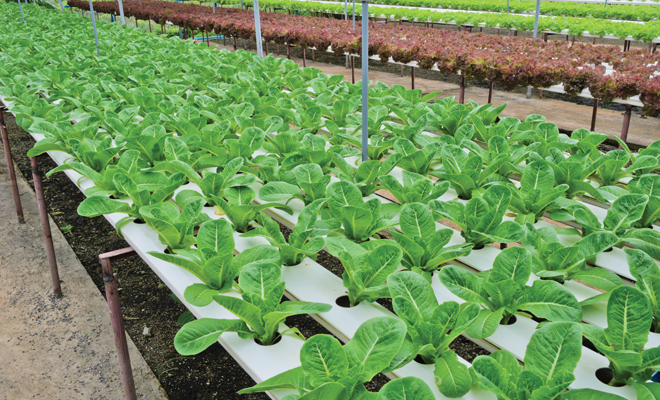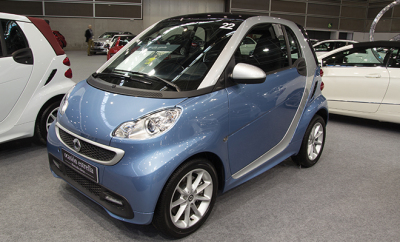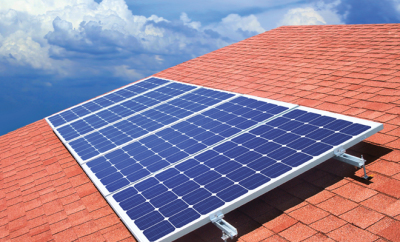
Green Living
Aquaponics: A Revolution in Sustainable Farming
Imagine being able to step into your back yard, or, for city dwellers, onto your deck, and harvest fish, greens and vegetables for your dinner in just a few minutes. For the forward-thinking proponents of aquaponics, fresh food and high-quality protein are the ultimate in locally sourced and sustainable agriculture.
Aquaponics, the melding of aquaculture, the raising of small aquatic life in water tanks, and hydroponics, the growing of plants in water and without soil, is considered the ultimate recycled, eco-friendly way to grow food. Today’s systems use space-efficient, closed, recirculating systems that combine fish tanks and plant troughs; fish waste provides fertilizer for the plants, while the plants clean the water for fish. In a balanced aquaponics garden, the symbiotic relationship among plants, bacteria and fish creates an environment in which all three thrive.
The concept of hydroponics can be traced back to ancient Chinese and Thai rice paddies and Egyptian farming practices along the Nile River. The early Aztecs in central Mexico devised an ingenious system to float islands called chinampas, in which plants were set in material dredged from the lake and canal bottoms and were irrigated by the water of Lake Tenochtitlan.
The organic nature of hydroponics lends itself to both commercial and home use. Depending on the climate, a system can be set up indoors or outside. A basement, spare room or garage can house a system as small as a 20- to-50-gallon aquarium, or a more extensive greenhouse can house an exterior operation that will provide a larger yield.
The Plant Chicago, a vertical farm and business incubator, resides in a 93,000-square-foot former pork processing facility; Bubbly Dynamics, LLC, purchased the building in 2010 and set about to fulfill its mission of providing a model for ecologically responsible and sustainable urban industrial development. The Plant uses the term “vertical gardening” to refer to farming in multiple stories of a building and farming from floor to ceiling in a room, resulting in more layers of crops planted per square acre than could be planted on a single flat farming surface. Tilapia is the fish of choice here; it’s a fresh-water fish that thrives in a crowded tank, grows quickly to a uniform size, and can be harvested in about ten months.
An equally symbiotic relationship exists among the educational non-profit FoodChain, the restaurant Smithtown Seafood and microbrewery West Sixth Brewing in Lexington, Kentucky. With assistance from Kentucky State University and University of Kentucky, FoodChain is focused on education about indoor agricultural food production. Students and researchers from both universities contributed expertise on aquaculture, aquaponics systems and sustainable agriculture. Also on tap for the project is developing a way to convert the spent grain from West Sixth Brewing into fish food. FoodChain provides tilapia, lettuce, herbs and microgreens to Smithtown Seafood, demonstrating, according to FoodChain’s executive director Becca Self, that alternative farming methods such as aquaponics are a viable supplement to traditional farming.
Dible Diversified Agriculture of Milroy, Pennsylvania, began as a family homestead on two acres; Denise and Jeff Dible wanted to raise healthy, naturally grown food for their family, and they were led to aquaponics by the desire to extend the growing season for their central Pennsylvania location. After much research, they installed a raft growing system designed by Nelson & Pade in half of their 728-square-foot greenhouse. The farm consists of four 110-gallon fish tanks, two clarifying tanks, two reactor tanks, a de-gassing tank and five raft tanks for the plants, interconnected with PVC pipe. Although Denise notes that there have been challenges, including finding methods of keeping the tilapia in the correct water temperature, loss of electricity at crucial times, and dealing with insect pests, she says that their system produces up to 100 plants per day, including basil, Swiss chard, endive and other leafy greens, plus hundreds of fish, and they regularly take their excess production to farmers’ markets.
A novice aquaponics enthusiast interested in getting her feet wet, so to speak, and producing sustainable, fresh greens and proteins for the family can invest in a minimal system for around $3,000; more complex systems with higher yields require a larger investment. Nelson & Pade’s Fantastically Fun Fresh Food Factory can annually produce 110 lbs. of fish and 900 to 1,440 heads of lettuce, other leafy crops or a variety of vegetables such as tomatoes, beans, cucumbers and more, with a single space-saving 110-gallon fish tank and two 15-square-foot plant grow beds. It also makes an ideal classroom aquaponics system to educate future farmers, scientists and environmentalists.
As climate change, water shortages and population growth continue, the science of aquaponics presents a sustainable alternative to traditional farming. It’s fun, educational and can be done in your own home; why not try it? HLM
Sources: acresusa.com, aquaponics.com, aquaponics-assoc.org, chevychaser.com, fao.org, foodchainlex.org, growingpower.org, plantchicago.com, skyygreens.com, state-journal.com and theaquaponicsgarden.com.
Why Aquaponics?
• High yields of mercury-free fish without creating water pollution
• Crop variety includes romaine, Bibb lettuce, kale, Swiss chard, watercress, spinach, chives, strawberries, tomatoes, peppers, yellow squash, beets, carrots and more
• No soil-borne diseases, since no soil is used
• No pesticides or herbicides mean healthier food
• Indoor or greenhouse-based systems provide food year-round
• Supports economic development in food deserts locally and globally









